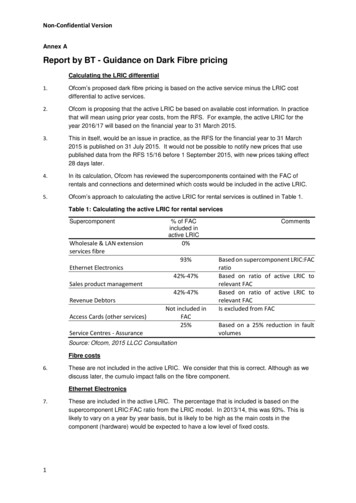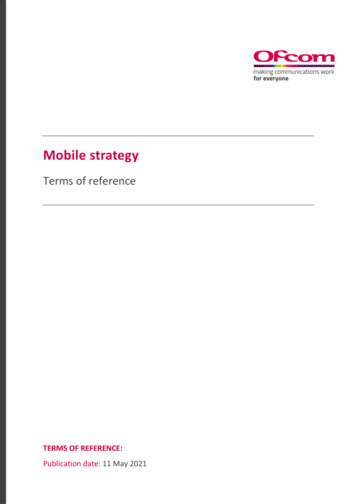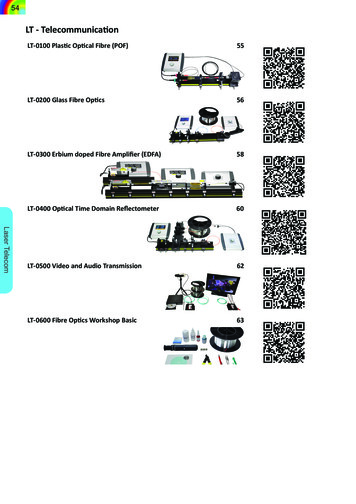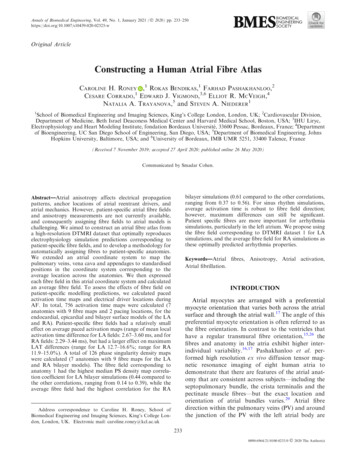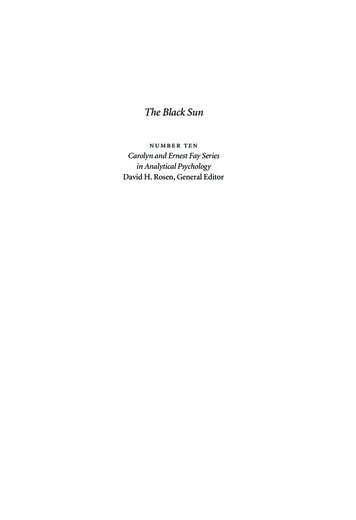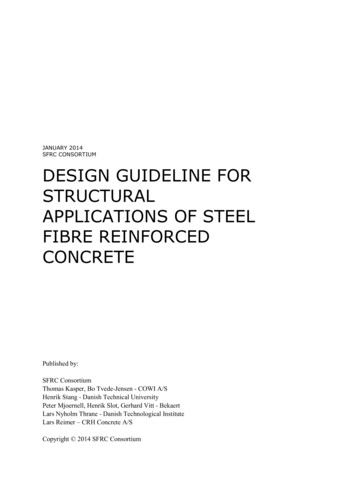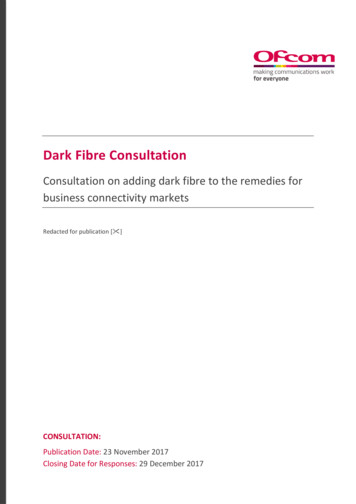
Transcription
Dark Fibre ConsultationConsultation on adding dark fibre to the remedies forbusiness connectivity marketsRedacted for publication [ ]CONSULTATION:Publication Date: 23 November 2017Closing Date for Responses: 29 December 2017
About this documentLeased lines are high-quality, dedicated, point-to-point data transmission services used bybusinesses and providers of communications services. As well as being essential components ofmany businesses communications systems, they are also essential to support the provision of mobiletelephone and fixed residential broadband services.We have found BT to have significant market power (SMP) in the provision of wholesale leased linesservices of all bandwidths at and below 1Gbit/s in many parts of the UK.This consultation sets out our proposal to introduce a dark fibre remedy to address BT’s SMP inthese markets. We believe that dark fibre is an important remedy in these markets as it offersgreater scope to unlock efficiency and innovation benefits than active remedies alone.
ContentsSection1. Introduction12. Market assessment63. Proposed dark fibre remedy94. Benefits, risks and costs of the proposed dark fibre remedy235. Impact on charge control44AnnexA1. Responding to this consultation50A2. Ofcom’s consultation principles53A3. Consultation coversheet54A4. Consultation questions55A5. Methodology for estimating cost savings57A6. Legal instruments63
Dark Fibre Consultation1. Introduction1.1In the 2016 BCMR Statement, Ofcom introduced a dark fibre remedy, requiring BT toprovide unlit strands of its optical fibre, to which access-seekers could attach their ownelectronic equipment to deliver business connectivity services. Dark fibre enablesinnovation and allows purchasers to save money on equipment costs, therefore supportingthe spread of fibre-based services across the UK.1.2For 15 months, between April 2016 and July 2017, industry worked with BT to develop thedetailed technical and operational aspects of the dark fibre product. During this period, inDecember 2016, BT published a reference offer for dark fibre. BT’s development costs forthe product have been funded by its customers, as BT was provided with an allowanceunder the 2016 Leased Lines Charge Control (2016 LLCC). BT has already incurred the vastmajority of the costs of developing a dark fibre product.1.3We understand that telecoms providers are keen to purchase dark fibre from BT and haveinvested in systems and processes to use it.1.4Dark fibre is, therefore, a product which BT is ready and able to provide, for which its costsof development have been covered, and for which it is clear to BT that there is demandfrom many of its key customers. Despite this, BT has chosen to not supply this product. 1We are consulting on requiring BT to provide dark fibre1.5The Competition Appeal Tribunal (the Tribunal) ruled that Ofcom erred in certain aspectsof its market definition in the 2016 BCMR Statement. As a result of this, Ofcom is removingthe remedies imposed under the 2016 BCMR Statement, including the dark fibre remedy. 2However, the Tribunal was not required to make any ruling about our assessment of darkfibre.1.6Today we are, in the BCMR Temporary Conditions Statement, 3 making temporary SMPfindings in respect of BT in wholesale leased line services of all bandwidths at and below1Gbit/s using contemporary interface (CI) technologies 4 (collectively referred to as LowerBandwidth CISBO services). 5 We have imposed temporary SMP obligations concerning esbriefingsarticles/eth02817.do.2 Ofcom, Business Connectivity Market Review 2016, Revocation of certain measures imposed in the business connectivitymarkets, 21 November 2017, https://www.ofcom.org.uk/ data/assets/pdf file/0018/108018/BCMR-RevocationNotification.pdf.3 Ofcom, Business Connectivity Markets, Temporary SMP conditions in relation to business connectivity services, 21November 2017 (BCMR Temporary Conditions Statement),https://www.ofcom.org.uk/ data/assets/pdf file/0019/108019/BCMR-Temporary-Conditions.pdf.4 Including Ethernet in the First Mile (EFM).5 Very High Bandwidth (VHB) CISBO services comprise wholesale leased line services above 1Gbit/s using CI technology andWDM services of all bandwidths.1
Dark Fibre Consultationsupply of active products in order to safeguard competition and protect the interests ofconsumers. These SMP obligations will remain in force until 31 March 2019.1.7In that context, we consider in this consultation whether to add a requirement on BT toprovide dark fibre in addition to the other remedies imposed in the BCMR TemporaryConditions Statement. As part of this dark fibre consultation, we are also consulting on themarket definition and SMP assessment set out in the BCMR Temporary ConditionsStatement.1.8We continue to believe that introducing dark fibre would promote efficiency and bettersustain effective competition than would be possible with active remedies alone. Thesebenefits would include: improving productive efficiencies by allowing providers to reduce equipment costsoverall; enhancing dynamic efficiencies by offering telecoms providers more scope to innovateand to differentiate their leased line services; and offering future opportunities to simplify regulation. 61.9In the 2016 BCMR Statement, a key element of ensuring a smooth transition to dark fibrewas the design of the remedy. Our review and proposals presented in this consultation arebased on the design of dark fibre determined in the 2016 BCMR Statement, as adapted forthe revised market definition.1.10We propose to retain the retail minus pricing approach with reference to BT’s 1Gbit/sactive services, as developed in the BCMR 2016 and subsequently revised in our decision toamend the way in which non-domestic business rates (NDR) are treated in the calculationof the dark fibre price. 7 We consider that this pricing approach will allow for a smoothintroduction of dark fibre in conjunction with existing active remedies. We consider thatour proposed approach will be an appropriate and proportionate way to introduce a darkfibre remedy that will more effectively address BT’s SMP in the Lower Bandwidth CISBOmarkets.1.11We recognise that telecoms providers may wish to use dark fibre in order to supplyservices above 1Gbit/s. However, we have not at this stage reached a conclusion as towhether BT has SMP in relation to these services. Therefore, as explained in section 3, wepropose that BT should be able to use contractual limitations to prevent the use of darkfibre to supply VHB CISBO services.1.12Under this approach, we believe that the case for dark fibre is clearer than it was under theBCMR 2016 8:Section 7, Volume 1, 2016 BCMR Statement reviews in detail the benefits of dark fibre access.Ofcom, Non-domestic rates and the price for regulated Dark Fibre, 30 June 2017 (2017 NDR Statement),https://www.ofcom.org.uk/ data/assets/pdf -fibre.pdf.8 Ofcom, Business Connectivity Market Review, 28 April 2016, (the 2016 BCMR ket-review-2015. When672
Dark Fibre Consultationa) The benefits of dark fibre remain significant, even in circumstances where BT maydecide to limit the use to services of 1Gbit/s or below.b) Productive efficiencies may be higher than we anticipated in 2016.c) The risks of introducing dark fibre in the Lower Bandwidth CISBO markets are low.d) Most of the costs of developing the dark fibre remedy have already been incurred.e) Having been through the development process, in conjunction with the industry, BThas established that it can supply a workable dark fibre product.1.13We do not consider it appropriate to postpone a reconsideration of dark fibre to the nextreview of the business connectivity markets. Dark fibre is almost ready for launch andtelecoms providers have invested in systems and processes to launch it.1.14In the light of the above we are consulting on whether to introduce a dark fibre remedy forthe period April 2018 to March 2019. We are consulting for a period of just over onemonth and the deadline for responses is 29 December 2017. In considering an appropriateduration of the consultation period, we have taken into account that the proposed darkfibre remedy is based to a large extent on the design and analysis of risks and benefits thatwere subject to extensive consultation under the BCMR 2016. We also recognise thatpotential purchasers, who had readied their operations to take a dark fibre product, needclarity on the course of regulation. We aim to notify a draft statement setting out ourconclusions in light of the consultation responses to the European Commission in early2018, followed by a final statement before the end of the first quarter of 2018.1.15In the BCMR Temporary Conditions Statement, we set the charge control for the Ethernetbasket, taking into account our dark fibre proposals. In the charge control modelling wehave updated our forecast of dark fibre take-up and the necessary cost uplifts, resulting ina control of CPI-13.50% in each of Period 1 and Period 2 of the control. This compares to acontrol of CPI-12.75% in each of Period 1 and Period 2 if we were to base our calculationson the 2016 BCMR Statement. 91.16We will consider the question of what overall package of remedies is appropriate for thebusiness connectivity markets in the next BCMR.referring to the 2016 Business Connectivity Market Review (BCMR 2016) or the 2016 BCMR Statement, we also refer to oursubsequent decision to amend the way in which non-domestic business rates are treated in the calculation of the darkfibre price as set out in our statement Non-domestic rates and the price for regulated Dark Fibre, 30 June 2017 (the 2017NDR Statement), https://www.ofcom.org.uk/ data/assets/pdf fibre.pdf.9 We estimate that absent a dark fibre remedy the Ethernet basket control would be CPI-14.50% in each of Period 1 andPeriod 2. Should we decide to not impose a dark fibre remedy in Spring 2018, we will update the final year of the chargecontrol accordingly.3
Dark Fibre ConsultationImpact assessment1.17The analysis presented in this consultation constitutes an impact assessment as defined insection 7 of the Communications Act 2003 (the Act).1.18Impact assessments provide a valuable way of assessing different options for regulationand showing why the preferred option was taken. They form part of best practice policymaking. This is reflected in section 7 of the Act, which means that generally we have tocarry out impact assessments where our proposals would be likely to have a significanteffect on businesses or the general public, or when there is a major change in Ofcom’sactivities. However, as a matter of policy, Ofcom is committed to carrying out impactassessments in relation to the great majority of our policy decisions. 10Equality impact assessment1.19Ofcom is separately required by statute to assess the potential impact of all our functions,policies, projects and practices on race, disability and gender equality. Equality ImpactAssessments (EIAs) also assist us in making sure that we are meeting our principal duty offurthering the interests of citizens and consumers regardless of their background oridentity.1.20It is not apparent to us that the proposals set out in this consultation are likely to have anyparticular impact on race, disability and gender equality. Specifically, we do not envisagethe impact of any outcome to be to the detriment of any group of society. Nor do weenvisage any need to carry out separate EIAs in relation to race or gender equality orequality schemes under the Northern Ireland and Disability Equality Schemes. This isbecause we anticipate that our regulatory intervention will not have a differential impactin relation to people of different gender or ethnicity, on consumers in Northern Ireland oron disabled consumers compared to consumers in general. Similarly, we do not considerthat our proposals will have a particular impact on consumers in different parts of the UKor between consumers on low incomes.Structure of this document1.21The structure of this document is as follows:a) In section 2, we explain our approach to market assessment for the purposes of thisreview. We consult on the market definition and SMP findings that we set out in theBCMR Temporary Conditions Statement.b) In section 3, we set out the design and implementation of our proposed dark fibreremedy, including our proposals to impose specific remedies relating to the provisionof dark fibre, including non-discrimination, requirements concerning a reference offer,For further information about our approach to impact assessments, see the guidelines, Better policy-making: Ofcom’sapproach to impact assessment, https://www.ofcom.org.uk/ data/assets/pdf file/0026/57194/better policy making.pdf104
Dark Fibre Consultationtransparency as to quality of service, and regulatory reporting of informationconcerning the provision of dark fibre.c) In section 4, we re-visit the benefits and costs of the proposed dark fibre remedy, inlight of its application to the Lower Bandwidth CISBO markets, and the fact that manyof the development costs of dark fibre have already been incurred.d) In section 5 we consider the impact of our proposed dark fibre remedy on the chargecontrol.5
Dark Fibre Consultation2. Market assessmentIntroduction2.1In the BCMR Temporary Conditions Statement, we decide that BT has SMP:a) in a market comprising wholesale leased line services of all bandwidths at and below1Gbit/s using contemporary interface (CI) technologies 11 (collectively referred to asLower Bandwidth CISBO services) in the London Periphery (LP);b) in markets comprising Lower Bandwidth CISBO services in the central business districts(CBDs) of each of Bristol and Manchester; andc) in a market comprising Lower Bandwidth CISBO services in the Rest of UK, excludingHull, the Central London Area (CLA), the LP and the CBDs of Bristol, Birmingham,Glasgow, Leeds and Manchester (RoUK excluding the Five CBDs).2.2We have also defined markets comprising Lower Bandwidth CISBO services in the CLA andthe CBDs of each of Birmingham, Glasgow and Leeds. However, we have not made an SMPfinding in relation to these markets.2.3We have decided that the CI core consists of links between any of: (a) the 107 exchangesspecified in column 2 of Schedule 22 of the BCMR Temporary Conditions Statement; (b) the56 trunk aggregation nodes (TANs) that we identified in the 2013 BCMR Statement 12(excluding links between exchanges within the same TAN); and (c) the 64 data centresidentified in the 2016 BCMR Statement.2.4The above market definitions and market power determinations will apply until 31 March2019.Approach to market assessment for the purposes of this review2.5We have considered whether it may be appropriate to introduce a dark fibre remedy toaddress BT’s SMP in the Lower Bandwidth CISBO markets by reference to the decisions wehave taken in the BCMR Temporary Conditions Statement on SMP and remedies. 13 Further,in accordance with our findings in the BCMR Temporary Conditions Statement, we haveevaluated our dark fibre remedy on the basis that we have not reached a conclusion as towhether BT has SMP in respect of wholesale leased line services above 1Gbit/s using CItechnology and WDM services of all bandwidths (collectively referred to Very HighBandwidth (VHB) CISBO services).This market includes Ethernet in the First Mile (EFM) but excludes WDM services of all bandwidths.Ofcom, Business Connectivity Market Review, 28 March 2013. ts/category-2/business-connectivity-mr13 We provide our reasoning on product market definition, geographic market definition and market power findings insection 2 of the BCMR Temporary Conditions Statement and do not reproduce it here.11126
Dark Fibre Consultation2.6The Tribunal has found Ofcom to have erred in relation to the various aspects of the 2016BCMR Statement market definition. We note in the BCMR Temporary ConditionsStatement that, in considering what steps it is appropriate to take, we have taken intoaccount the Tribunal’s reasoned judgment, reaching conclusions where we have been ableto conduct the analysis necessary to address the Tribunal’s findings, or where it is clearthat our conclusions would not be affected by the Tribunal’s findings. We have used thoseparts of Ofcom’s reasoning and analysis from the BCMR 2016 which the Tribunal’sjudgment did not overturn, taking into account new evidence that has arisen since thecompletion of the BCMR 2016.2.7There are therefore some services in relation to which we have been able to conclude thatBT has SMP on a forward-looking basis until 31 March 2019. These conclusions are basedon the analysis carried out in the BCMR 2016, taking into account the Tribunal’s judgmentand new evidence that has arisen since the completion of the BCMR 2016.2.8In defining markets for this purpose, we were mindful that market definition is not an endin itself, but it is a tool to enable the assessment of market power. 14 For this reason, weapproached the exercise of defining markets with a view to identifying services where wecould find that BT has SMP on the basis of the evidence and analysis available to us now.2.9The absence of an SMP finding in respect of specific services, areas or exchanges shouldtherefore not be taken as a conclusion that those services, areas or exchanges arecompetitive, nor does it prejudge the outcome of the market assessment in our nextBCMR.2.10As part of this dark fibre consultation we are consulting under section 84(2) of the Act onthe market definition and SMP assessment set out in the BCMR Temporary ConditionsStatement. Section 84(2) of the Act provides that where we have identified and analysed amarket for the purposes of making a market power determination, we may carry outfurther analyses of that market for one or both of the following purposes:a) reviewing market power determinations made on the basis of an earlier analysis;b) deciding whether to make proposals for the modification of SMP conditions set byreference to a market power determination made on such a basis.2.11As set out in section 4, we consider that introducing dark fibre would promote efficiencyand better sustain effective competition than would be possible with active remediesalone. We are therefore consulting on proposals to modify the BCMR TemporaryConditions to add our proposed dark fibre remedy. In doing so, we consider it is alsoappropriate to review the market power determinations made in the BCMR TemporarySee for example paragraph 2 of the European Commission Notice on the Definition of the Relevant Market for thePurposes of Community Competition Law. It is also notable that in some circumstances competition authorities will notconsider it necessary to conclude on the boundaries of a market at all: see for example paragraph 5.2.4 of the CompetitionCommission and Office of Fair Trading Merger Assessment ystem/uploads/attachment data/file/284449/OFT1254.pdf.147
Dark Fibre ConsultationConditions Statement by asking for views and evidence on the markets defined and onwhether BT has SMP in the Lower Bandwidth CISBO markets until 31 March 2019.2.12If our further analyses of the Lower Bandwidth CISBO markets, following responses to thisconsultation, lead us to conclude that any aspect of the market definition or SMPassessment contained in the BCMR Temporary Conditions Statement is incorrect, we willconsider what remedies (if any) would continue to be appropriate. Conversely, if ourfurther analyses following this consultation confirm our decisions in respect of the marketdefinition and SMP assessment contained in the BCMR Temporary Conditions Statement,the decisions contained in the BCMR Temporary Conditions Statement (including thoserelating to the imposition of the BCMR Temporary Conditions and directions) will remain inforce until 31 March 2019.Question 2.1: Do you agree with our findings in relation to product market definition asset out in paragraphs 2.9 to 2.13 of the BCMR Temporary Conditions Statement, namelythat we define a market comprising wholesale leased line services of all bandwidths atand below 1Gbit/s using contemporary interface (CI) technologies, including EFM? Pleaseset out your reasons and supporting evidence for your response.Question 2.2: Do you agree with our findings in relation to geographic market definitionas set out in paragraphs 2.14 to 2.19 of the BCMR Temporary Conditions Statement,namely that we define the following geographic markets: (a) the CLA; (b) the LP; (c) theCBDs of each of Birmingham, Bristol, Leeds, Glasgow and Manchester; and (d) the RoUKexcluding the Five CBDs? Please set out your reasons and supporting evidence for yourresponse.Question 2.3: Do you agree with our assessment of the CI Core, as set out in paragraphs2.101 to 2.111 of the BCMR Temporary Conditions Statement? Please set out yourreasons and supporting evidence for your response.Question 2.4: Do you agree with our findings that BT has SMP in the markets for LowerBandwidth CISBO services in the LP, the CBDs of each of Bristol and Manchester and theRoUK excluding the Five CBDs, up to the end of March 2019, as set out in paragraphs 2.20to 2.100 of the BCMR Temporary Conditions Statement? Please set out your reasons andsupporting evidence for your response.8
Dark Fibre Consultation3. Proposed dark fibre remedyIntroduction3.1In this section, we explain why we consider that introducing a passive remedy in the formof dark fibre in the Lower Bandwidth CISBO markets would promote efficiency and bettersustain effective competition than would be possible with active remedies alone.3.2We explain why we continue to believe that the design of the dark fibre remedyestablished in the BCMR 2016, with adjustments to take account of our SMP findings, willensure a smooth transition to passive remedies in these markets.3.3We then present the details of the scope and design of our proposed dark fibre remedy.This is summarised in Table 3.1.Table 3.1: Summary of the proposed dark fibre remedy on the Lower Bandwidth CISBO marketsObligationSpecific accessobligationSummaryProvide dark fibre terminating segments upon reasonable request and onfair and reasonable terms and conditions and charges.Provide dark fibre terminating segments, including: Disaggregated access and backhaul segmentsShort range end-to-end segmentsNon-discrimination No undue discriminationEquivalence of inputsPricing‘Active-minus’ by reference to the corresponding 1Gbit/s active product andthe distributed long run incremental cost (LRIC) of its active elements,complemented by guidance on the calculation of the LRIC of the activeelements. 15Reference Offer Specified minimum requirements for the Reference Offer.Service Level Agreements (SLAs) and Service Level Guarantees (SLGs) tobe agreed and finalised as part of industry negotiations regardingproduct specification and to enter into force six months after the launchof dark fibre.Implementation Publish a Reference Offer within one month of the date of thepublication of the Final Statement.Launch dark fibre access within one month of the date of thepublication of the Final Statement. 16 1516See Annex 24 of the 2016 BCMR Statement as revised by Annex 3 of the 2017 NDR Statement.As noted in section 1, we intend to publish our final statement before the end of the first quarter of 2018.9
Dark Fibre ConsultationObligationSummaryTransparency as toquality of service Regulatoryfinancial reportingrequirementsInformation published in the RFS: Key Performance Indicators (KPIs) defined in Direction.Reporting requirements to come into effect three months from launch.Dark Fibre Services: (Non-Confidential Statements); the total volumes,average prices and revenues for dark fibre non-LA, dark fibre LA servicesand dark fibre Main Link Services (including their variants)volume, average price, revenue and total FAC cost for BT’s dark fibreservices in aggregateInformation provided to Ofcom in private: 3.4The schedule entitled ‘Dark Fibre Services Revenues and Costs’.The proposed dark fibre access obligation is in addition to the package of remedies wehave decided to impose on BT in the BCMR Temporary Conditions Statement. This reflectsthe fact that the industry continues to rely on active remedies.We continue to believe a dark fibre remedy is appropriate3.5A contemporary interface leased line is comprised of optical fibre connecting two locationsand equipment on each end of the line which is used to 'light' the fibre to transmitinformation between locations. The physical components of a leased line service can becategorised as 'active' components (e.g. electronics) and 'passive' components (e.g. ductand unlit fibre). The passive components can be thought of as a necessary input into activeservices and as such we refer to passive services as being higher up the supply chain.3.6Prior to the 2016 BCMR Statement, Ofcom's remedies in the leased line market requiredthat BT, as the SMP provider, provided only regulated 'active' services. This meant thattelecoms providers who wished to offer their own leased line services were unable topurchase passive inputs from BT and use these in combination with active components tocreate their own active services.3.7In the 2016 BCMR Statement, we concluded that introducing a passive remedy in the formof dark fibre would promote efficiency and better sustain effective competition in fibrebased leased lines than would be possible with active remedies alone. We concluded that apassive remedy in the form of dark fibre would allow rival providers to create their ownactive services by purchasing passive inputs from BT. We considered that this wouldexpose active components to competition, thereby facilitation greater competition inleased lines.3.8In the BCMR Temporary Conditions Statement, we impose a set of active remedies toaddress BT’s SMP. This consultation proposes to impose a dark fibre remedy to operatealongside the BCMR Temporary Conditions. We believe that a combination of passive andactive remedies in the business connectivity markets is the most effective package of10
Dark Fibre Consultationremedies to protect consumers and promote competition during the transition periodtowards greater reliance on passive remedies.3.9We believe that the analysis of dark fibre conducted in the 2016 BCMR Statement is, inmost respects, also applicable to our assessment of the most effective set of remedies toaddress the competition problems we have identified in the Lower Bandwidth CISBOmarkets. We believe that introducing dark fibre will result in the following benefits (whichwere first identified in the BCMR 2016): 17a) Cost savings (productive efficiency) – More of the supply chain is exposed tocompetitive pressure. This will give telecoms providers opportunities to avoidduplication of electronic equipment, thus reducing costs. We have reason to expectthat benefits from this source are greater than we believed in 2016. In addition,telecoms providers may be able to realise synergies between the electronic equipmentadopted and downstream services. There may also be a cost impact from reduced faultfrequency.b) Greater scope for innovation (dynamic efficiency) – Allowing telecoms providers tohave greater control and flexibility in developing their services in respect of the activelayer gives them greater scope to develop new and bespoke services and/or optimisetheir network design.c) Potential reduction in downstream regulation – Promoting competition based onregulated access to dark fibre (in combination with competition from end-to-endinfrastructure providers) would enable the downstream regulation of active productsto be reduced or eliminated in the future. Although we do not expect this benefit to berealised before 31 March 2019, it aligns with our longer term aim of favouringremedies further up the supply chain.3.10As in the BCMR 2016, we recognise that introducing a remedy higher up the supply chaincreates risks. 18 We concluded in the 2016 BCMR Statement that these risks could beaddressed by the design and pricing of dark fibre access.3.11We consider below, by reference to the design elements of the dark fibre remedy in the2016 BCMR Statement, the design of an appropriate and proportionate way to introduce adark fibre remedy intended to address BT's SMP in the Lower Bandwidth CISBO markets. Indoing so, we explain whether any changes to the design and pricing are necessary. Insection 4 we then consider the benefits and costs of this proposed remedy.3.12We note that in the Wholesale Local Access (WLA) review we have proposed to amend thecurrent usage restrictions on physical infrastructure access (PIA) to enable telecomsproviders to use the PIA remedy to deploy local access networks offering both broadbandand non-broadband services (including leased lines) provided that the purpose of thenetwork deployment is primarily the delivery of broadband services to homes and1718Our detailed assessment of the benefits of the proposed dark fibre remedy is set out in section 4.Our detailed assessment of the impacts and risks of the proposed dark fibre remedy is set out in section 4.11
Dark Fibre Consultationbusinesses. We consider that this mixed use may enable investment in the provision ofbroadband services more generally. 193.13We expect to publish our final decisions concluding the WLA review in early 2018, withnew measures taking effect on 1 April 2018. If the current usage restrictions on the PIA areamended as proposed, telecoms providers will only be able t
majority of the costs of developing a dark fibre product. 1.3 We understand that telecoms providers are keen to purchase dark fibre from BT and have invested in systems and processes to use it. 1.4 Dark fibre is, therefore, a product which BT is ready and able to provide, for which its costs
